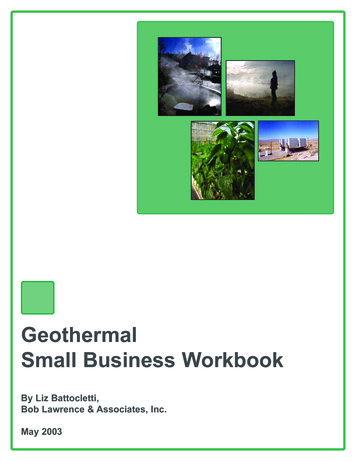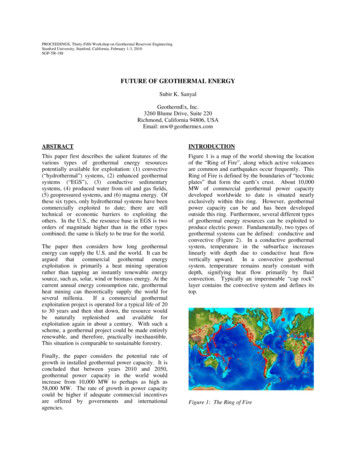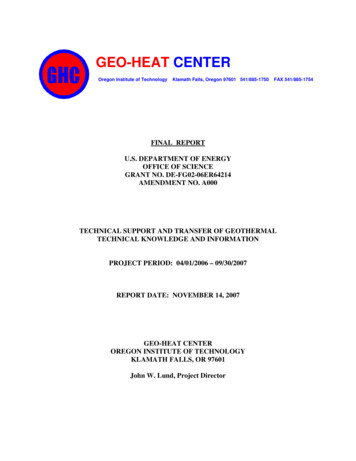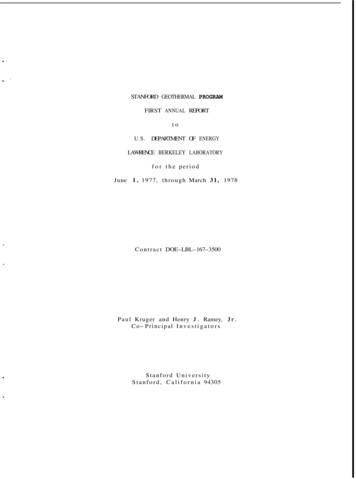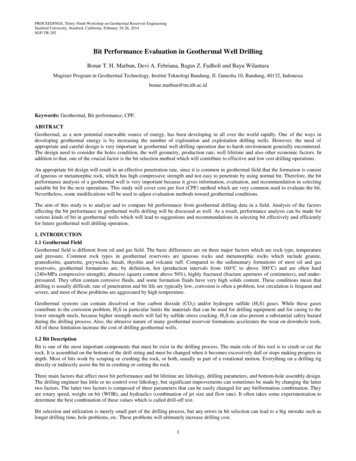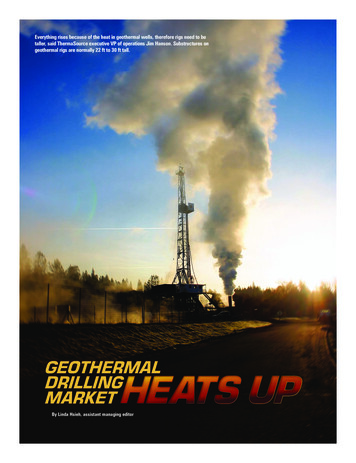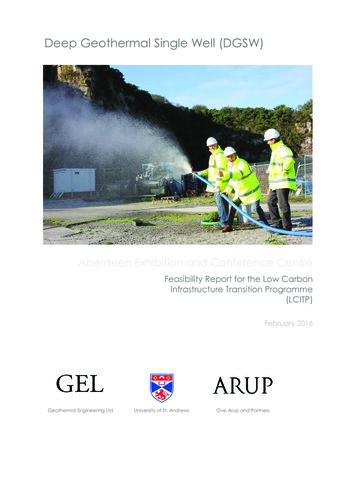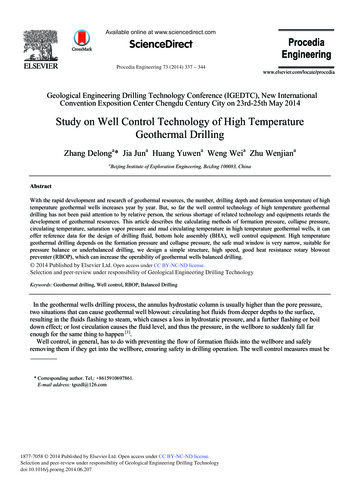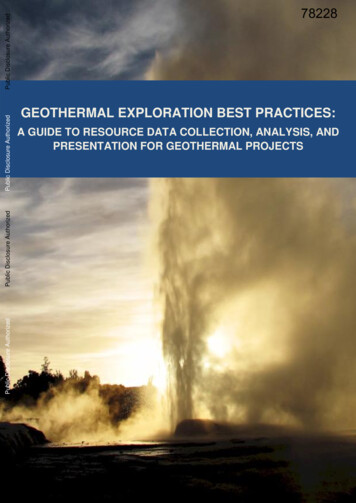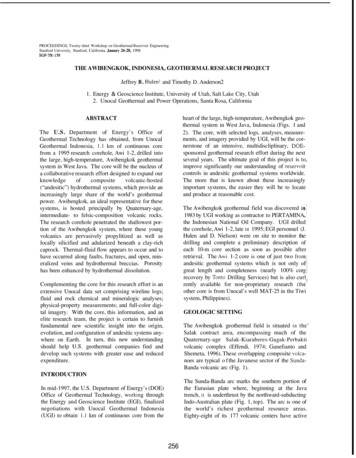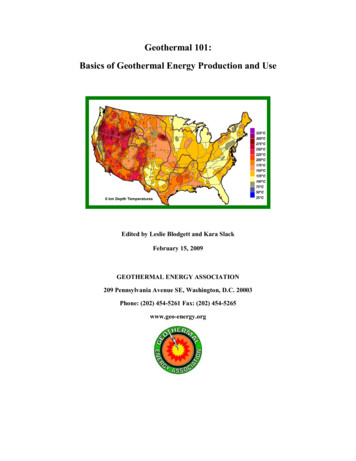
Transcription
Geothermal 101:Basics of Geothermal Energy Production and UseEdited by Leslie Blodgett and Kara SlackFebruary 15, 2009GEOTHERMAL ENERGY ASSOCIATION209 Pennsylvania Avenue SE, Washington, D.C. 20003Phone: (202) 454-5261 Fax: (202) 454-5265www.geo-energy.org
INTRODUCTION. 5LIST OF FIGURES . 6LIST OF TABLES. 61. BASICS. 71.1. What is geothermal energy?. 71.2. How does a conventional geothermal reservoir work?. 71.3. What are the different ways in which geothermal energy can be used?. 81.4. How does a geothermal power plant work?. 102. CURRENT USE . 142.1. How many homes are served by geothermal power plants?. 142.2. How much geothermal electricity is currently supplied to the U.S.?. 142.3. Are geothermal projects currently being developed in the U.S.? . 152.4. How much energy does geothermal supply worldwide? . 153. POTENTIAL USE . 173.1. What is the official government estimate of potential geothermal electricresource in the U.S.?. 173.2. Are there other examples of how geothermal resources are utilized? . 183.3. How much energy is geothermal electricity capable of supplying to the U.S.? . 203.4. Where are geothermal resources located? . 213.5. How much electricity can geothermal supply worldwide? . 264. POLICY . 284.1. What laws govern geothermal energy? . 284.2. What policies or laws are providing support to new geothermal development?. 285. NATIONAL SECURITY . 302
5.1. Natural gas prices are soaring, and our oil reserves are continually depleting.What is the best short-term solution to these mounting problems? . 305.2. How can geothermal energy contribute to national security? . 306. ENVIRONMENT. 316.1. Why is geothermal energy considered to be renewable? . 316.2. How do geothermal plants compare to fossil fuel-fired power plants? . 316.3. Can geothermal energy help reduce global warming?. 326.4. Can geothermal energy offset other environmental impacts?. 336.5. How much land does geothermal energy production require?. 336.6. Aren’t geothermal plants noisy?. 346.7. Don’t geothermal plants consume water?. 346.8. How can geothermal energy help reduce health impacts and healthcare costs?. 347. ECONOMIC BENEFITS . 367.1. What does the U.S. geothermal industry contribute to the economy?. 367.2. What are some specific examples of ways in which geothermal energy hascontributed to local economies?. 367.3. Will geothermal energy influence tourism in my area? . 377.4. What types of communities benefit most from geothermal development? . 387.5. How much money does the geothermal industry contribute to the U.S. economy?. 397.6. Aren’t there hidden costs associated with energy development?. 397.7. Where can I learn more about the economics of geothermal energy? . 398. POWER PLANT COSTS. 408.1. How much does a geothermal power plant cost?. 408.2. How much does power from a geothermal power plant cost? . 408.3. Does the price of geothermal power fluctuate like the price of oil and gas? . 413
8.4. What factors influence the cost of a geothermal power plant? . 418.5. What else should I consider about the cost of geothermal power compared withother technologies?. 428.6. Don’t geothermal power plants cost a lot more than a gas or coal power plant?. 428.7. How will the cost of geothermal energy compare to the cost of fossil fuel in thefuture? . 429. EMPLOYMENT . 449.1. What types of jobs are created by the geothermal sector, and how long will theylast? . 449.2. How many people currently work in the U.S. geothermal industry? . 449.3. How many jobs will be supported by the geothermal industry in the future? . 4510. MYTH BUSTERS . 47Myth #1: Geothermal Energy is Experimental and Not Yet Widely Used . 47Myth #2: Geothermal Power Plants Emit Smoke . 47Myth #3: Extraction and Injection of Geothermal Water Contaminates Drinking Water. 48Myth #4: Natural Geothermal Surface Features Are Used During GeothermalDevelopment . 49FOR MORE INFORMATION . 50NOTES AND REFERENCES . 524
INTRODUCTIONGeothermal energy, the heat of the Earth, provides continuous, 24-hour a day, clean, sustainableenergy production. Together, advances in technology, private investment, and governmentsupport are increasing geothermal energy production in the U.S. and worldwide. Geothermal101: Basics of Geothermal Energy Production and Use gives an overview of what you shouldknow about this renewable energy resource. It includes simple definitions, descriptions, andfigures and cites key national reports that provide further information. The benefits of usinggeothermal energy are explained on a national, economic and environmental level. This reportanswers the common questions about geothermal energy and provides you with up-to-dateinformation and references. Although more emphasis is given in this report to geothermalelectricity production, other applications such as geothermal heat pumps and direct heating usesare also covered. Whether you are new to the basics or have been working in the field for years,this report provides valuable information.Acknowledgments: We wish to acknowledge all those who have contributed to this report,including John Pritchett of SAIC, Roy Mink of US Geothermal, Dan Fleischmann of Ormat, andJeff Tester and his graduate students at MIT. This work is based upon various reports anddocuments, among the principal authors were Alyssa Kagel, Diana Bates, Nathanael Hance,Mark Taylor, and Karl Gawell. Special thanks to Marilyn Nemzer and the GeothermalEducation Office for extensive input and support. The final document was prepared, written, andedited by Leslie Blodgett and Kara Slack with assistance and input from many individuals. Weshould also acknowledge the hundreds of individuals who reviewed the earlier reports fromwhich materials are derived, particularly A Guide to Geothermal Energy and the Environment, AHandbook on the Externalities, Employment, and Economics of Geothermal Energy, The Stateof Geothermal Energy, Part I: Subsurface Technology, and The State of Geothermal Technology,Part II: Surface Technology. Each of these reports is available from the GEA Web site sp.Cover art heat flow map courtesy of SMU Geothermal Laboratory.5
LIST OF FIGURESFigures courtesy of the Geothermal Energy Association unless otherwise indicated.Figure 1: Earth's Temperatures (Geothermal Education Office)Figure 2: The Formation of a Geothermal Reservoir (Geothermal Education Office)Figure 3: Typical Direct Use Geothermal Heating System Configuration (Geo-Heat Center)Figure 4: Geothermal Heat Pump Diagram (Geo-Heat Center)Figure 5: Flash Power Plant Diagram (Geo-Heat Center)Figure 6: Dixie Valley, NV, Flash Power PlantFigure 7: The Geysers, CA, Dry Steam Plant (Geothermal Education Office)Figure 8: Dry Steam Plant Diagram (Geothermal Education Office)Figure 9: Binary Power Plant (Geo-Heat Center)Figure 10: Burdett, NV, Binary Power Plant (Ormat Technologies)Figure 11: Flash/Binary Power Plant Diagram (Geo-Heat Center)Figure 12: Puna, HI, Flash/Binary (Ormat Technologies)Figure 13: Kalina Power Plant in Husavik, Iceland (Glitnir Bank)Figure 14: Renewable Energy Generation in California 1983-2006 (California EnergyCommission)Figure 15: Chena Hot Springs, AK, Gains Distributed Generation Begins in 2006 (UTC Power)Figure 16: Geopressured Demonstration Plant in Texas (Richard Campbell, TIC)Figure 17: Soultz, France, 1.5-MW EGS Power Plant (Soultz Project, France)Figure 18: United States Heat Flow Map (SMU Geothermal Laboratory)Figure 19: Hydrothermal Areas in the Western United States (Idaho National Laboratory)Figure 20: SMU Estimated Co-Produced Geothermal Potential (Southern Methodist University)Figure 21: Geopressured Basins in the United States (U.S. Department of Energy)Figure 22: Location of Geothermal Projects and Resources (Geo-Heat Center)Figure 23: Geothermal Heat Pump Installations in 2006 (Dan Ellis, Climate Master)Figure 24: 30-Year Land Use ComparisonFigure 25: Flowing Steam Through a Silencer at Coso, a Double Flash Plant in California (U.S.Navy Geothermal. Program Office)Figure 26: Blue Lagoon, Iceland, Draws Tourists to its Geothermal Hot Springs (Geo-HeatCenter)Figure 27: Levelized Costs of Selected Technologies (California Energy Commission)Figure 28: Steam Rising from a Geothermal Power Plant (Geothermal Education Office)LIST OF TABLESTable 1: Emissions from Geothermal Facilities Compared with Coal Facilities (GeothermalEnergy Association)Table 2: Summary of Western States' Near-Term Geothermal Potential and ResultingEmployment and Economic Contribution (Geothermal Energy Association)6
1. BASICS1.1. What is geothermal energy?Geothermal energy is defined as heat from the Earth. It is a clean, renewable resource thatprovides energy in the U.S. and around the world in a variety of applications and resources.Although areas with telltale signs like hot springs are more obvious and are often the first placesgeothermal resources are used, the heat of the earth is available everywhere, and we are learningto use it in a broader diversity of circumstances. It is considered a renewable resource becausethe heat emanating from the interior of the Earth is essentially limitless. The heat continuouslyflowing from the Earth’s interior, which travels primarily by conduction, is estimated to beequivalent to 42 million megawatts (MW) of power, and is expected to remain so for billions ofyears to come, ensuring an inexhaustible supply of energy.(1)Figure 1: Earth’s Temperatures1.2. How does a conventional geothermal reservoir work?A geothermal system requires heat, permeability, and water. The heat from the Earth's corecontinuously flows outward. Sometimes the heat, as magma, reaches the surface as lava, but itusually remains below the Earth's crust, heating nearby rock and water — sometimes to levels ashot as 700 F. When water is heated by the earth’s heat, hot water or steam can be trapped inpermeable and porous rocks under a layer of impermeable rock and a geothermal reservoir canform. This hot geothermal water can manifest itself on the surface as hot springs or geysers, butmost of it stays deep underground, trapped in cracks and porous rock. This natural collection ofhot water is called a geothermal reservoir.7
Figure 2: The Formation of a Geothermal Reservoir1.3. What are the different ways in which geothermal energy can be used?Geothermal energy can be used for electricity production, for commercial, industrial, andresidential direct heating purposes, and for efficient home heating and cooling throughgeothermal heat pumps. For a video presentation on the different ways to use geothermal energy,visit http://geothermal.marin.org/video/vid pt5.html. Geothermal Electricity: To develop electricity from geothermal resources, wells aredrilled into a geothermal reservoir. The wells bring the geothermal water to thesurface, where its heat energy is converted into electricity at a geothermal power plant(see below for more information about the different types of geothermal electricityproduction). Heating Uses: Geothermal heat is used directly, without involving a power plant or aheat pump, for a variety of applications such as space heating and cooling, foodpreparation, hot spring bathing and spas (balneology), agriculture, aquaculture,greenhouses, and industrial processes. Uses for heating and bathing are traced back toancient Roman times.(2) Currently, geothermal is used for direct heating purposes atsites across the United States. U.S. installed capacity of direct use systems totals 470MW or enough to heat 40,000 average-sized houses, according to the GeoHeat CenterWeb site, http://geoheat.oit.edu/.The Romans used geothermal water to treat eye and skin disease and, at Pompeii, toheat buildings. Medieval wars were even fought over lands with hot springs. The firstknown "health spa" was established in 1326 in Belgium at natural hot springs. And forhundreds of years, Tuscany in Central Italy has produced vegetables in the winterfrom fields heated by natural steam. (See the Geothermal Education Office Web site,http://geothermal.marin.org/).8
A few examples of geothermal direct use applications today are at the Idaho CapitolBuilding in Boise apital.html, BurgettGeothermal Greenhouses in Cotton City, New .htm, and Roosevelt Warm SpringsInstitute for Rehab in Warm Springs, ure 3: Typical Direct Use Geothermal Heating System Configuration1300F(550C)PLATE )GEOTHERMALPRODUCTIONWELLHEADEQUIPMENT PUNITGeothermal Heat Pumps (GHPs): Geothermal heat pumps take advantage of theEarth’s relatively constant temperature at depths of about 10 ft to 300 ft. GHPs can beused almost everywhere in the world, as they do not share the requirements offractured rock and water as are needed for a conventional geothermal reservoir. GHPscirculate water or other liquids through pipes buried in a continuous loop, eitherhorizontally or vertically, under a landscaped area, parking lot, or any number of areasaround the building. The Environmental Protection Agency considers them to be oneof the most efficient heating and cooling systems available.Animals burrow underground for warmth in the winter and to escape the heat of thesummer. The same idea is applied to GHPs, which provide both heating and coolingsolutions. To supply heat, the system pulls heat from the Earth through the loop anddistributes it through a conventional duct system. For cooling, the process is reversed;the system extracts heat from the building and moves it back into the earth loop. It canalso direct the heat to a hot water tank, providing another advantage — free hot water.GHPs reduce electricity use 30–60% compared with traditional heating and coolingsystems, because the electricity which powers them is used only to collect,concentrate, and deliver heat, not to produce it.For more information about GHPs, please visit www.geoexchange.org andhttp://www.igshpa.okstate.edu.9
Figure 4: Geothermal Heat Pump Diagramverticalhorizontaldirecttwo wellpond1.4. How does a geothermal power plant work?There are four commercial types of geothermal power plants: a. flash power plants, b. dry steampower plants, c. binary power plants, and d. flash/binary combined power plants.a. Flash Power Plant: Geothermally heated water under pressure is separated in asurface vessel (called a steam separator) into steam and hot water (called “brine” in theaccompanying image). The steam is delivered to the turbine, and the turbine powers agenerator. The liquid is injected back into the reservoir.Figure 5: Flash Power Plant DiagramFigure 6: Dixie Valley, NV, Flash Plantb. Dry Steam Power Plant: Steam is produced directly from the geothermal reservoir torun the turbines that power the generator, and no separation is necessary because wellsonly produce steam. The image below is a more simplified version of the process.10
Figure 7: The Geysers, CA, Dry Steam PlantFigure 8: Dry Steam Plant Diagramc. Binary Power Plant: Recent advances in geothermal technology have made possiblethe economic production of electricity from geothermal resources lower than 150 C(302 F). Known as binary geothermal plants, the facilities that make this possible reducegeothermal energy’s already low emission rate to zero. Binary plants typically use anOrganic Rankine Cycle system. The geothermal water (called “geothermal fluid” in theaccompanying image) heats another liquid, such as isobutane or other organic fluids suchas pentafluoropropane, which boils at a lower temperature than water. The two liquids arekept completely separate through the use of a heat exchanger, which transfers the heatenergy from the geothermal water to the working fluid. The secondary fluid expands intogaseous vapor. The force of the expanding vapor, like steam, turns the turbines thatpower the generators. All of the produced geothermal water is injected back into thereservoir.Figure 9: Binary Power PlantFigure 10: Burdett, NV, Binary Power Plantd. Flash/Binary Combined Cycle: This type of plant, which uses a combination of flashand binary technology, has been used effectively to take advantage of the benefits of bothtechnologies. In this type of plant, the portion of the geothermal water which “flashes” to11
steam under reduced pressure is first converted to electricity with a backpressure steamturbine and the low-pressure steam exiting the backpressure turbine is condensed in abinary system.Figure 11: Flash/Binary Power Plant DiagramFigure 12: Puna, HI, Flash/BinaryFor more information about the above four types of power plants, access GEA’s EnvironmentalGuide or Surface Technology Report.In addition to different power plant technologies in use today, additional applications andtechnologies continue to emerge. The following are some commonly discussed as areas of futuredevelopment: Enhanced Geothermal Systems (EGS): Although the deeper crust and interior of theEarth is universally hot, it lacks two of the three ingredients required for a naturallyoccurring geothermal reservoir: water and interconnected open volume for watermovement. Producing electricity from this naturally occurring hot, but relatively dryrock requires enhancing the potential reservoir by fracturing, pumping water into andout of the hot rock, and directing the hot water to a geothermal power plant. Researchapplications of this technology are being pursued in the U.S., France, Australia, andelsewhere.(3) EGS is also sometimes referred to as Hot Dry Rock. See furtherdiscussion of EGS in section 3.2. Mixed Working Fluid/Kalina System: As of January 2009 the Kalina System wasbeing used at two power plants. The first is a small demonstration power plantoperated as part of Iceland's Husavik GeoHeat Project. The second plant to use theKalina System is in Germany at the Unterhaching Power Station. The Kalina cycleuses an ammonia-water mixed working fluid for high efficiency. The Kalina cycle isonly one of the possible mixed working fluid approaches to possibly achieving greaterheat transfer efficiency and/or lower temperature production of power.(4)12
Figure 13: Kalina Power Plant in Husavik, Iceland Distributed Generation: Geothermal applications can be sized and constructed atgeographically remote sites in order to meet on-site electricity demands. Examples ofremote geothermal power systems are at Chena Hot Springs in Alaska and at the RockyMountain Oil and Gas Testing Center (RMOTC) in Wyoming. In the first, the unitpowers a remote resort, in the second the power supplies electricity to operate an oilfield. For more information about the Chena Hot Springs Project, visit aska/Alaska.asp. For more information about theRMOTC project, visit http://www.rmotc.doe.gov/. Supercritical Cycles: Supercritical fluids are at a temperature and pressure that candiffuse through solids. A supercritical fluid such as carbon dioxide can be pumped intoan underground formation to fracture the rock, thus creating a reservoir for geothermalenergy production and heat transport. The supercritical fluid used to form the reservoircan heat up and expand, and is then pumped out of the reservoir to transfer the heat to asurface power plant or other application. An example of work in this area is theIceland Deep Drilling Project, and for more information on this effort visithttp://www.iddp.is.13
2. CURRENT USE2.1. How many homes are served by geothermal power plants?The geothermal power production in the U.S. today provides enough electricity to meet theelectricity needs of about 2.4 million California households.(1) This does not includecontributions from geothermal heat pumps and direct heating uses.2.2. How much geothermal electricity is currently supplied to the U.S.?In 2007, geothermal was the fourth largest source of renewable energy in the U.S. Today theU.S. has about 3,000 MW of geothermal electricity connected to the grid.(2) Geothermalenergy generated 14,885 gigawatt-hours (GWh) of electricity in 2007, which accounted for 4%of renewable energy-based electricity consumption in the U.S. (including large hydropower).(3)The U.S. continues to produce more geothermal electricity than any other country, comprisingapproximately 30 percent of the world total.(4)In California, the state with the largest amount of geothermal power on line, electricity fromgeothermal resources accounted for 5 percent of the state’s electricity generation in 2003 on aper kilowatt hour basis.(5) Geothermal is the largest non-hydro renewable energy source in thestate, significantly exceeding the contribution of wind and solar combined.Figure 14: Renewable Energy Generation in California 1983-200614
2.3. Are geothermal projects currently being developed in the U.S.?Yes. As of August 2008, almost 4,000 MW of new geothermal power plant capacity was underdevelopment in the U.S. (this includes projects in the initial development phases). Those stateswith projects currently under consideration or development are: Alaska, Arizona, California,Colorado, Florida, Hawaii, Idaho, Nevada, New Mexico, Oregon, Utah, Washington, andWyoming. Combined, these states have approximately 103 projects in development ranging frominitial to advanced stages.(6)Direct uses applications of geothermal energy occur today in 26 states—almost as many states asproduce coal.(7) New direct use projects are encouraged by the provisions of the GeothermalSteam Act Amendments passed by Congress in 2005. There is interest in new direct use projectsin numerous states and on various Indian reservations within several states.Geothermal heat pump installations have been growing at an annual rate of 15 percent, withmore than 600,000 units installed in the U.S. by the end of 2005. Every year in the U.S., 50,000to 60,000 new units are installed—the largest growth in the world for geothermal heat pumps.(8)2.4. How much energy does geothermal supply worldwide?Geothermal energy supplies more than 10,000 MW to 24 countries worldwide and now producesenough electricity to meet the needs of 60 million people.(9) The Philippines, which generates23% of its electricity from geothermal energy, is the world’s second biggest producer behind theU.S.(10) Geothermal energy has helped developing countries such as Indonesia, the Philippines,Guatemala, Costa Rica, and Mexico. The benefits of geothermal projects can preserve thecleanliness of developing countries seeking energy and economic independence, and it canprovide a local source of electricity in remote locations, thus raising the quality of life.Iceland is widely considered the success story of the geothermal community. The country of justover 300,000 people is now fully powered by renewable forms of energy, with 17% of electricityand 87% of heating needs provided by geothermal energy (fossil fuels are still imported forfishing and transportation needs). Iceland has been expanding its geothermal power productionlargely to meet growing industrial and commercial energy demand. In 2004, Iceland wasreported to have generated 1465 gigawatt-hours (GWh) from geothermal resources; geothermalproduction is expected to reach 3000 GWh this year (2009).GEA’s May 2007 Interim Report: Update on World Geothermal Development named thecountries producing geothermal electricity: 21 Countries Generating Geothermal Power in 2000: Australia, China, Costa Rica, ElSalvador, Ethiopia, France (Guadeloupe), Guatemala, Iceland, Indonesia, Italy, Japan,15
Kenya, Mexico, New Zealand, Nicaragua, Philippines, Portugal (Azores), Russia,Thailand, Turkey, United States 3 Countries Adding Power Generation by 2005 (for a total of 24): Austria, Germany,Papua New Guinea 22 Potential New Countries by 2010 (for potential total of 46): Armenia, Canada,Chile, Djibouti, Dominica, Greece, Honduras, Hungary, India, Iran, Korea, Nevis,Rwanda, Slovakia, Solomon Islands, St. Lucia, Switzerland, Taiwan, Tanzania,Uganda, Vietnam, YemenGeothermal electricity generation is likely to expand. According to the International GeothermalAssociation (IGA) in IGA News 72 (April–June 2008), total global geothermal capacity isexpected to rise to 11 GW by 2010.(11) See also section 3.5.In addition to large power generation, geothermal is also used for direct use purposes worldwide.In 2005, 72 countries reported using geothermal energy for direct heating, providing more than16,000 MW of geothermal energy. Geothermal energy is used directly for a variety of purposes,including space heating, snow melting, aquaculture, greenhouse production, and more.(12)16
3. POTENTIAL USE3.1. What is the official government estimate of potential geothermal electric resource inthe U.S.?The heat of the Earth is considered limitless; its use is only limited by technology and theassociated costs. Technology development and further studies are expected to show even greaterpotential, but here we have cited the first part of a new assessment released in September 2008by the U.S. Geological Survey (USGS).(1) The report focuses on 13 western states and breaksthe geothermal estimate into three categories: Identified Geothermal Systems: The resource is either liquid or vapor dominated and hasmoderate to high temperature. The resource is either producing (the reservoir is currentlygenerating electric power), confirmed (the reservoir has been evaluated with a successfulcommercial flow test of a production well), or potential (there are reliable estimates oftemperature and volume for the reservoir but no successful well tests to date). Undiscovered Geothermal Resources: Geothermal resources were assessed for the same 13states in which the identified resources a
7 1. BASICS 1.1. What is geothermal energy? Geothermal energy is defined as heat from the Earth. It is a clean, renewable resource that provides energy in the U.S. and around the world in a variety of applications and resources.
